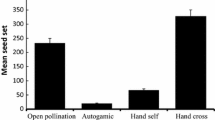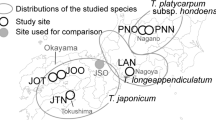Abstract
Pollen limitation occurs when sexual reproduction is decreased due to inadequate pollen receipt. Limitation is usually associated with the quality and the quantity of pollen; still, most studies do not discriminate between the two. We used hand-pollination experiments and observations of floral visitors to determine the mating system and limitations to seed production of the Spanish endangered species Pseudomisopates rivas-martinezii. We tested for agamospermy, autogamy, obligated autogamy, cross-pollination and supplementation. The response variables considered were fruit set, seed set and viable seed set. Previous studies indicated that (i) the species exhibits extensive clonal growth, (ii) plants flower profusely in summer, (iii) seeds showed to be highly unviable, and (iv) no seedlings were observed in the field. We found that P. rivas-martinezii is predominantly self-incompatible, has an unexpected generalized pollination system considering its occluded corolla, and is limited by qualitative rather than quantitative pollen limitation. These results indicate that, in addition to other presumed environmental factors, the low seed viability of this self-incompatible species is due to pollen quality limitation as a result of reduced mate availability.

Similar content being viewed by others
References
Aigner PA (2004) Floral specialization without trade-offs: optimal corolla flare in contrasting pollination environments. Ecology 85:2560–2569
Aizen MA, Harder LD (2007) Expanding the limits of the pollen-limitation concept: effects of pollen quantity and quality. Ecology 88:271–281
Anderson MJ (2001) A new method for non-parametric multivariate analysis of variance. Austral Ecol 26:32–46
Ashman TL, Knight TM, Steets JA, Amarasekare P, Burd M, Campbell DR, Dudash MR, Johnston MO, Mazer SJ, Mitchell RJ, Morgan MT, Wilson WG (2004) Pollen limitation of plant reproduction: ecological and evolutionary causes and consequences. Ecology 85:2408–2421
Burd M (1994) Bateman’s principle and plant reproduction: the role of pollen limitation in fruit and seed set. Bot Rev 60:83–139
Busch JW, Schoen DJ (2008) The evolution of self-incompatibility when mates are limiting. Trends Plant Sci 13:128–136
Byers DL (1995) Pollen quantity and quality as explanations for low seed set in small populations. Am J Bot 82:1000–1006
Campbell LG, Husband BC (2007) Small populations are mate-poor but pollinator-rich in a rare, self-incompatible plant, Hymenoxys herbacea (Asteraceae). New Phyt 174:915–925
Carrió E, Jiménez JF, Sánchez-Gómez P, Güemes J (2009) Reproductive biology and conservation implications of three endangered snapdragon species (Antirrhinum, Plantaginaceae). Biol Conserv 142:1854–1863
Chambers JC (1989) Seed viability of alpine species: variability within and among years. J Range Manag 42:304–308
Charlesworth D, Charlesworth B (1987) Inbreeding depression and its evolutionary consequences. Annu Rev Ecol Evol Syst 18:237–268
Charpentier A, Grillas P, Thompson JD (2000) The effects of population size limitation on fecundity in mosaic populations of the clonal macrophyte Scirpus maritimus (Cyperaceae). Am J Bot 87:502–507
Colwell RK (2005) EstimateS—statistical estimation of species richness and shared species from samples, version 7.5. http://www.purl.oclc.org/estimates
Dafni A, Kevan Peter G, Husband BC (2005) Practical pollination biology. Enviroquest Ltd., Cambridge
DeMauro MM (1993) Relationship of breeding system to rarity in the lakeside daisy (Hymenoxys acaulis var glabra). Conserv Biol 7:542–550
East EM (1940) The distribution of self-sterility in the flowering plants. Proc Am Phil Soc 82:449–518
Elle E, Carney R (2003) Reproductive assurance varies with flower size in Collinsia parviflora (Scrophulariaceae). Am J Bot 90:888–896
Fenster CB, Armbruster WS, Wilson P, Dudash MR, Thomson JD (2004) Pollination syndromes and floral specialization. Annu Rev Ecol Evol Syst 35:375–403
García-Camacho R, Totland O (2009) Pollen limitation in the alpine: a meta analysis. Arc Antarct Alp Res 41:103–111
Gómez JM, García D (1997) Interactions between a high-mountain shrub, Genista versicolor (Fabaceae), and its seed predators. Ecoscience 4:48–56
Gómez JM, Bosch J, Perfectti F, Fernández J, Abdelaziz M (2007) Pollinator diversity affects plant reproduction and recruitment: the tradeoffs of generalization. Oecologia 153:597–605
González-Varo JP, Arroyo J, Aparicio A (2009) Effects of fragmentation on pollinator assemblage, pollen limitation and seed production of Mediterranean myrtle (Myrtus communis). Biol Conserv 142:1058–1065
Goodwillie C (1999) Multiple origins of self-incompatibility in Linanthus section Leptosiphon (Polemoniaceae): phylogenetic evidence from internal-transcribed-spacer sequence data. Evolution 53:1387–1395
Gotelli NJ, Entsminger GL (2004) EcoSim: null models software for ecology, version 7. Acquired Intelligence Inc. and Kesey-Bear, Jericho. http://garyentsminger.com/ecosim/index.htm
Gottlieb D, Keasar T, Shmida A, Motro U (2005) Possible foraging benefits of bimodal daily activity in Proxylocopa olivieri (Lepeletier) (Hymenoptera: Anthophoridae). Environ Entomol 34:417–424
Hamrick JL, Godt MJW, Murawski DA, Loveless MD (1991) Correlations between species traits and allozyme diversity: implications for conservation biology. In: Falk DA, Holsinger KE (eds) Genetics and conservation of rare plants. Oxford University Press, New York, pp 75–86
Harder DH, Aizen MA (2010) Floral adaptation and diversification under pollen limitation. Phil Trans R Soc Lond B 365:529–543
Hardy OJ, González-Martínez SC, Colas B, Fréville H, Mignot A, Olivieri I (2004) Fine-scale genetic structure and gene dispersal in Centaurea corymbosa (Asteraceae) II. Correlated paternity within and among sibships. Genetics 168:1601–1614
Hegland SJ, Totland Ø (2008) Is the magnitude of pollen limitation in a plant community affected by pollinator visitation and plant species specialization levels? Oikos 117:883–891
Herrera CM, Vega C, Canto A, Pozo MI (2009) Yeasts in floral nectar: a quantitative survey. Ann Bot 103:1415–1423
Honnay O, Jacquemyn H, Roldán-Ruiz I (2006) Consequences of prolonged clonal growth on local and regional genetic structure and fruiting success of the forest perennial Maianthemum bifolium. Oikos 112:21–30
Husband BC, Schemske DW (1996) Evolution of the magnitude and timing of inbreeding depression in plants. Evolution 50:54–70
Juan R, Fernández I, Pastor JE (1995) Ecología de la germinación en especies del género Veronica (Scrophulariaceae) de SO de España. Acta Bot Malac 20:43–50
Klein AM, Steffan-Dewenter I, Tscharntke T (2003) Fruit set of highland coffee increases with the diversity of pollinating bees. Proc R Soc Lond B 270:955–961
Knight TM, Steets JA, Vamosi JC, Mazer SJ, Burd M, Campbell DR, Dudash MR, Johnston M, Mitchell RJ, Ashman TL (2005) Pollen limitation of plant reproduction: ecological and evolutionary causes and consequences. Annu Rev Ecol Evol Syst 36:467–497
Larson BMH, Barrett SCH (2000) A comparative analysis of pollen limitation in flowering plants. Biol J Linn Soc 69:503–520
Lau JA, Galloway LF (2004) Effects of low-efficiency pollinators on plant fitness and floral trait evolution in Campanula americana (Campanulaceae). Oecologia 141:577–583
Les DH, Reinartz JA, Esselman EJ (1991) Genetic consequences of rarity in Aster furcatus (Asteraceae), a threatened, self-incompatible plant. Evolution 45:1641–1650
Magurran AE (2004) Ecological diversity and its measurements, 2nd edn. Princeton University Press, Princeton
Martínez Rodríguez J, Valcárcel Núñez V, Fiz Palacios O, Vargas Gómez P (2004) Pseudomisopates rivas-martinezii. In: Bañares A, Blanca G, Güemes J, Moreno JC, Ortiz S (eds) Atlas y Libro Rojo de la Flora Vascular Amenazada de España. Dirección General de Conservación de la Naturaleza, Madrid, pp 450–451
Mateu-Andrés I, Segarra-Moragues JG (2004) Reproductive system in the Iberian endangered endemic Antirrhinum valentinum F.Q. (Antirrhineae, Scrophulariaceae): consequences for species conservation. Int J Plant Sci 165:773–778
Müller L (1929) Anatomisch-biomechanische Studien an maskierten Scrophulariaceen-blüten. Österr Bot Zeits 80:149–161
Nadeau JR, King LB (1991) Seed dispersal and seedling establishment of Linaria vulgaris Mill. Can J Plant Sci 71:771–782
Nieto Feliner G (1999) Vascular plant distribution in the Iberian Peninsula and the Balearic Islands: current projects. Acta Bot Fenn 162:23–33
Perfectti F, Gómez JM, Bosch J (2009) The functional consequences of diversity in plant-pollinator interactions. Oikos 118:1430–1440
Peters J (ed) (2000) Tetrazolium testing handbook 2000. Contribution no. 29. Association of Official Seed Analysts (AOSA), USA
Proctor MP, Yeo P, Lack A (1996) The natural history of pollination. Timber Press, Portland
Sánchez-LaFuente AM (2007) Corolla herbivory, pollination success and fruit predation in complex flowers: an experimental study with Linaria lilacina (Scrophulariaceae). Ann Bot 99:355–364
Saner MA, Jeanneret P, Müller-Schärer H (1994) Interaction among two biological control agents and the developmental stage of their target weed, Dalmatian toadflax Linaria dalmatica (l.) Mill. (Scrophulariaceae). Biocontrol Sci Tech 4:215–222
Schemske DW, Horvitz CC (1984) Variation among floral visitors in pollination ability: a precondition for mutualism specialization. Science 225:519–521
Schemske DW, Willson MF, Melampy MN, Miller LJ, Verner L, Schemske KM, Best LB (1978) Flowering ecology of some spring woodland herbs. Ecology 59:351–366
Silvertown J (2008) The evolutionary maintenance of sexual reproduction: evidence from the ecological distribution of asexual reproduction in clonal plants. Int J Plant Sci 169:157–168
Stout JC, Allen JA, Goulson D (2000) Nectar robbing, forager efficiency and seed set: bumblebees foraging on the self incompatible plant Linaria vulgaris (Scrophulariaceae). Acta Oecol 21:277–283
Sutton DA (1988) A revision of the tribe Antirrhineae. Oxford University Press, London
Thompson JD (2001) How do visitation patterns vary among pollinators in relation to floral display and floral design in a generalist pollination system? Oecologia 126:386–394
Totland O, Schulte-Herbrüggen B (2003) Breeding system, insect flower visitation, and floral traits of two alpine Cerastium species in Norway. Arc Antarct Alp Res 35:242–247
Totland Ø, Sottocornola M (2001) Pollen limitation of reproductive success in two sympatric alpine willows (Salicaceae) with contrasting pollination strategies. Am J Bot 88:1011–1015
Tseng H (1938) Self-sterility in Antirrhinum and Petunia. J Genet 36:127–138
Vallejo-Marín M, Uyenoyama MK (2004) On the evolutionary costs of self-incompatibility: incomplete reproductive compensation due to pollen limitation. Evolution 58:1924–1935
Vargas P, García B (2008) Plant endemics to Sierra de Gredos (central Spain): taxonomic, distributional, and evolutionary aspects. Anales J Bot Madr 65:353–366
Vargas P, Ornosa C, Ortiz-Sánchez FJ, Arroyo J (2010) Is the occluded corolla of Antirrhinum bee-specialized? J Nat Hist 00:1–16
Vaughton G, Ramsey M (2010) Floral emasculation reveals pollen quality limitation of seed output in Bulbine bulbosa (Asphodelaceae). Am J Bot 97:174–178
Ward M, Jonson SD (2005) Pollen limitation and demographic structure in small fragmented populations of Brunsvigia radulosa (Amaryllidaceae). Oikos 108:253–262
Wiens D (1984) Ovule survivorship, brood size, life history, breeding systems, and reproductive success in plants. Oecologia 64:47–53
Acknowledgments
We thank Bernardo García Muñoz for information on populations, Gonzalo García-Baquero and Jorge Martínez for field assistance, and Concepción Ornosa for bee identification. The Consejería de Medio Ambiente of the Junta de Castilla y León granted permission to work in Gredos Regional Park. This research was supported by the Spanish General Direction of Scientific and Technical Research (DGICYT) through the project CGL2009-1003 and a Spanish MARM grant (078/2007). MEA was supported by an FPU fellowship (AP2005-0160) from the Spanish Ministry of Education.
Author information
Authors and Affiliations
Corresponding author
Electronic supplementary material
Below is the link to the electronic supplementary material.
Rights and permissions
About this article
Cite this article
Amat, M.E., Vargas, P. & Gómez, J.M. Pollen quality limitation in the Iberian critically endangered genus Pseudomisopates (Antirrhinaceae). Plant Ecol 212, 1069–1078 (2011). https://doi.org/10.1007/s11258-010-9887-6
Received:
Accepted:
Published:
Issue Date:
DOI: https://doi.org/10.1007/s11258-010-9887-6




